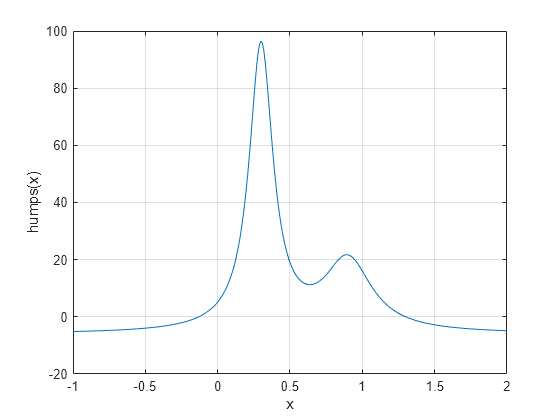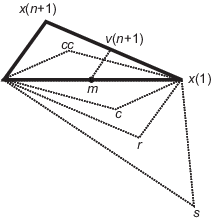优化非线性函数
求一元函数的最小值
如果给定了一个一元数学函数,可以使用 fminbnd 函数求该函数在给定区间中的局部最小值点。例如,请考虑 MATLAB® 提供的 humps.m 函数。下图显示了 humps 的图。
x = -1:.01:2; y = humps(x); plot(x,y) xlabel('x') ylabel('humps(x)') grid on

若要计算 humps 函数在 (0.3,1) 范围内的最小值,请使用
x = fminbnd(@humps,0.3,1)
x = 0.6370
您可以通过使用 optimset 创建选项并将 Display 选项设置为 'iter' 来查看求解过程的详细信息。将所得选项传递给 fminbnd。
options = optimset('Display','iter'); x = fminbnd(@humps,0.3,1,options)
Func-count x f(x) Procedure
1 0.567376 12.9098 initial
2 0.732624 13.7746 golden
3 0.465248 25.1714 golden
4 0.644416 11.2693 parabolic
5 0.6413 11.2583 parabolic
6 0.637618 11.2529 parabolic
7 0.636985 11.2528 parabolic
8 0.637019 11.2528 parabolic
9 0.637052 11.2528 parabolic
Optimization terminated:
the current x satisfies the termination criteria using OPTIONS.TolX of 1.000000e-04
x = 0.6370
这种迭代输出显示了 x 的当前值以及每次计算函数时 f(x) 处的函数值。对于 fminbnd,一次函数计算对应一次算法迭代。最后一列显示 fminbnd 在每次迭代中使用的过程,即黄金分割搜索或抛物线插值。有关详细信息,请参阅优化求解器迭代输出。
注意:优化求解器适用于实数值函数。复数值无法优化(除了复数值的实数值函数,例如范数)。
求多元函数的最小值
fminsearch 函数与 fminbnd 类似,不同之处在于前者处理多变量函数。请指定起始向量 x0,而非起始区间。fminsearch 尝试返回一个向量 x,该向量是数学函数在此起始向量附近的局部最小值点。
要尝试执行 fminsearch,请创建一个三元(即 x、y 和 z)函数 three_var。
function b = three_var(v)
x = v(1);
y = v(2);
z = v(3);
b = x.^2 + 2.5*sin(y) - z^2*x^2*y^2;现在,使用 x = -0.6、y = -1.2 和 z = 0.135 作为起始值求此函数的最小值。
v = [-0.6,-1.2,0.135]; a = fminsearch(@three_var,v)
a =
0.0000 -1.5708 0.1803注意
优化求解器适用于实数值函数。复数值无法优化(除了复数值的实数值函数,例如范数)。
求函数最大值
fminbnd 和 fminsearch 求解器尝试最小化目标函数。如果您有最大化问题,即以下形式的问题:
然后定义 g(x) = –f(x),并最小化 g。
例如,要计算 tan(cos(x)) 在 x = 5 附近的最大值,请计算:
[x fval] = fminbnd(@(x)-tan(cos(x)),3,8)
x =
6.2832
fval =
-1.5574最大值为 1.5574(报告的 fval 的负值),并出现在 x = 6.2832。此答案是正确的,因为最大值为 tan(1) = 1.5574(最多五位数),该值出现在 x = 2π = 6.2832 位置。
fminsearch 算法
fminsearch 使用拉加里亚斯等人的著作 [1] 中所述的内尔德-米德单纯形算法。此算法对 n 维向量 x 使用 n + 1 个点组成的单纯形。此算法首先向 x0 添加各分量 x0(i) 的 5%,以围绕初始估计值 x0 生成一个单纯形。然后,该算法使用上述 n 个向量作为单纯形的除 x0 之外的元素。(如果 x0(i) = 0,则算法使用 0.00025 作为分量 i)。然后,此算法按照以下过程反复修改单纯形。
注意
fminsearch 迭代输出方式中的关键字在相应的步骤说明后以粗体形式显示。
用 x(i) 表示当前单纯形中的点列表 i = 1,...,n + 1。
按最小函数值 f(x(1)) 到最大函数值 f(x(n + 1)) 的顺序对单纯形中的点进行排序。在迭代的每个步骤中,此算法都会放弃当前的最差点 x(n + 1) 并接受单纯形中的另一个点。[或者在下面的步骤 7 中,此算法会更改值在 f(x(1)) 上方的所有 n 个点。]
生成反射点
r = 2m – x(n + 1), (1) 其中
m = Σx(i)/n, i = 1...n, (2) 并计算 f(r)。
如果 f(x(1)) ≤ f(r) < f(x(n)),则接受 r 并终止此迭代。反射
如果 f(r) < f(x(1)),则计算延伸点 s
s = m + 2(m – x(n + 1)), (3) 并计算 f(s)。
如果 f(s) < f(r),接受 s 并终止迭代。扩展
否则,接受 r 并终止迭代。反射
如果 f(r) ≥ f(x(n)),则在 m 和 x(n + 1) 或 r(取目标函数值较低者)之间执行收缩。
如果 f(r) < f(x(n + 1))(即 r 优于 x(n + 1)),则计算
c = m + (r – m)/2 (4) 并计算 f(c)。如果 f(c) < f(r),则接受 c 并终止迭代。外收缩
否则,继续执行步骤 7(收缩)。
如果 f(r) ≥ f(x(n + 1)),则计算
cc = m + (x(n + 1) – m)/2 (5) 并计算 f(cc)。如果 f(cc) < f(x(n + 1)),则接受 cc 并终止迭代。内收缩
否则,继续执行步骤 7(收缩)。
计算 n 点
v(i) = x(1) + (x(i) – x(1))/2 (6) 并计算 f(v(i)),i = 2,...,n + 1。下一迭代中的单纯形为 x(1), v(2),...,v(n + 1)。收缩
下图显示了 fminsearch 可在此过程中计算的点以及每种可能的新单纯形。原始单纯形采用粗体边框。迭代将在符合停止条件之前继续运行。

参考
[1] Lagarias, J. C., J. A. Reeds, M. H. Wright, and P. E. Wright. “Convergence Properties of the Nelder-Mead Simplex Method in Low Dimensions.” SIAM Journal of Optimization, Vol. 9, Number 1, 1998, pp. 112–147.